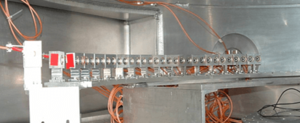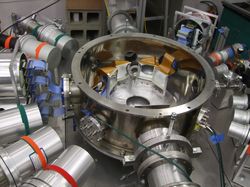Silicon Detectors
SAND

Silicon strip detector Array at Notre Dame (SAND) consists of six YY1-type, one S1-type and one S2-type silicon strip detectors designed to cover most of the backward angles for the detection of light charged particles. These detectors are 300 um thick and manufactured by Micron Semiconductor Ltd. Each wedge-shaped YY1 detector is segmented into 16 strips on the front side with six of them forming a "lampshade" configuration. The CD-shaped S2 detector is doubled sided and has 48 rings on the front and 16 segments on the back. The other CD-shaped S1 detector is also doubled sided and has 64 strips on the front and 16 pies on the back. The total 240 channels of the full array are read out by the ASIC electronics and the NSCL VMUSB DAQ system implemented at Notre Dame.
Photo-Diode Array

DSSD ArrayA Photo-Diode Array was developed for high precision scattering experiments conducted at the R2D2 beam line in the East Target Room. It consists of 32 500 um thick photo-diode detectors made by Hamamatsu. They are typically placed on the rotatable table inside the large R2D2 scattering chamber (about 1.6m in diameter). The geometrical angular position can be reproducible to an accuracy of 0.01 degrees and therefore the array is very good for high precision measurements of angular distributions.
DSSD Array

Four BB7-type double-sided silicon strip detectors are combined to provide high angular resolution and large solid angle coverage for nuclear experiments. Each of the BB7 detectors is 300 um thick and has dimensions of 64 mm x 64 mm in active area. Both sides of the detectors are segmented into 32 strips with a pitch of 2 mm. The total 256 channels of the array are processed with the same ASIC electronics and DAQ system development for SAND.